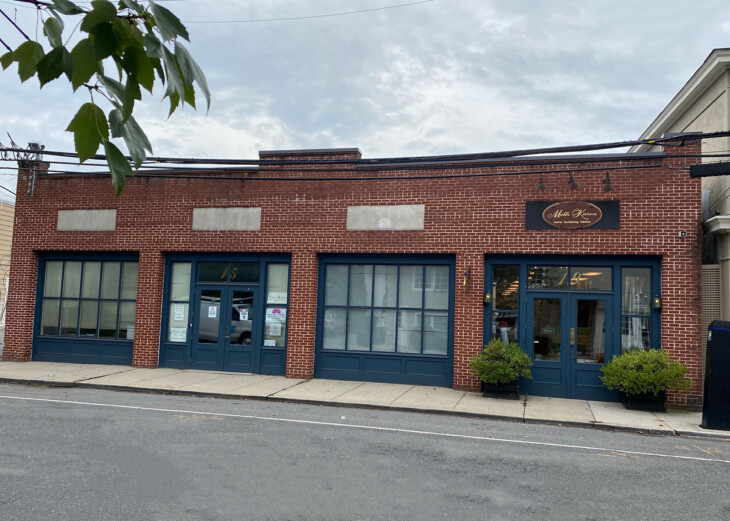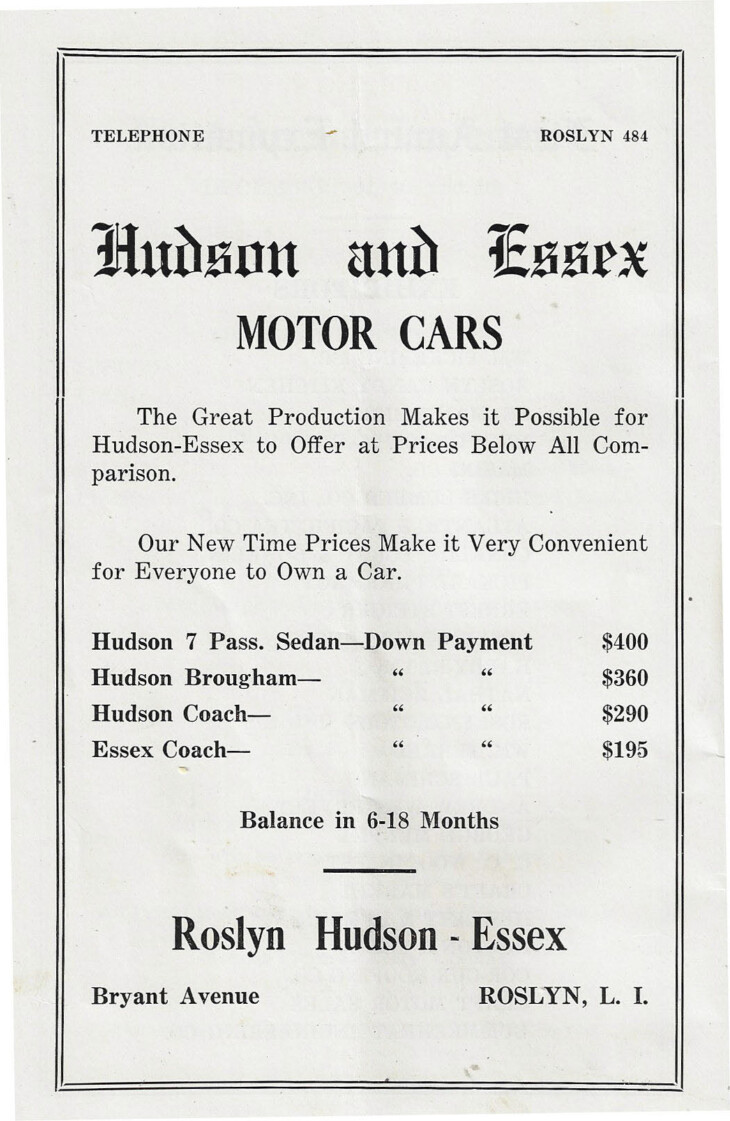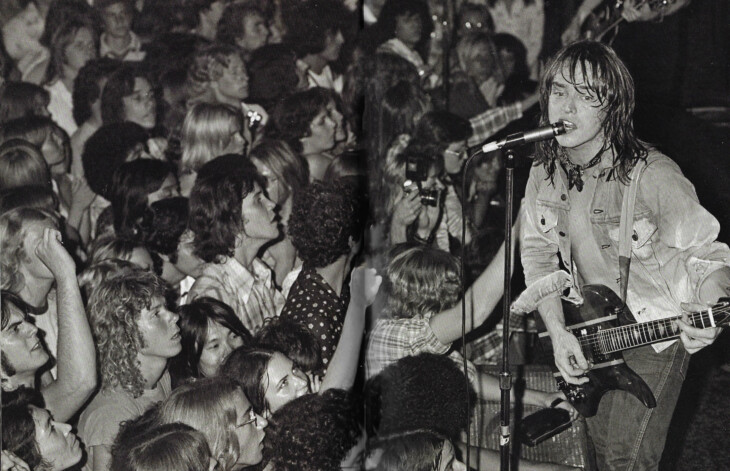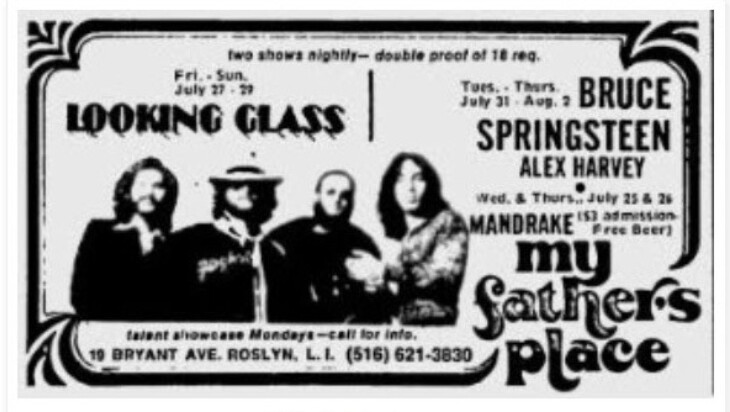My Father's Place
19 Bryant Avenue, Roslyn

The building was originally built in 1920 as a single story garage for the Roslyn Hudson-Essex automobile dealership. During its use as a garage, it had three openings across the street front, two of which were used as vehicular entrances. One opening had an extra high opening, possibly added toward the end of the building's use as a garage for trucks.
The front is defined by a simple shaped parapet, the columns at each end rising slightly above the parapet, as does a central block. The building is a cinder block construction, faced with all stretcher brick courses which have a roughened "rustic" quality.
Subsequent uses for the building include: Town of North Hempstead meeting room and court room, S & K Hardware (1954), Roslyn Bowling (October 1955-9 lane duck pin bowling) and My Father's Place club and restaurant (1971).
___________________________________________________________________________________________
There was a time in Long Island's cultural history when the whole world looked here for the next big trend in rock 'n' roll. That was between 1974 and 1980, the heyday of My Father's Place, a cabaret in Roslyn. And Michael Epstein, known as Eppy, ran the whole shebang. Along with My Father's Place, which opened on Memorial Day in 1971 with a concert by Richie Havens, a confluence of entities created a scene that would influence music for decades to come.
The New York Times, August 27, 2000.
Between 1971 and 1987, My Father’s Place presented an unmatched and unforgettable range of talent in rock, jazz, fusion, country, punk, soul, reggae, folk, and comedy. The club was especially known as a place for aspiring artists such as Madonna, Bruce Springsteen, Aerosmith, Billy Joel, Charlie Daniels, Linda Ronstadt, Stevie Ray Vaughn, Tom Petty, and so many more. Not just musicians, but young comedians like Billy Crystal, Eddie Murphy, and Andy Kaufman also got their start there.
On June 29, 2018, My Father’s Place is re-opening June 29th in the ballroom of the Roslyn Hotel, in Roslyn, New York, with David Johansen aka Buster Poindexter presiding over the grand opening ceremonies. As befits a legendary club, the sound system in the new, reborn My Father’s Place had to be special.
“Even back in the early 1970s, My Father’s Place had a great sounding system. We had McIntosh amplifiers powering Altec-Lansing speakers and then moved to JBL speakers.” The old club was known as being artist-friendly, such as having the most comfortable dressing rooms on the circuit. “I experienced the evolution of rock clubs,” he says. “When I started, everybody huddled around one microphone, like the old country acts, wired to home-made amplifiers and speakers. There was no such thing as a stage monitors. But the rock bands needed more and more power, more and more inputs, and then they needed to hear themselves through all of this, so we had to constantly change to make the artists happy.”
Epstein had the major manufacturers come to the club and set up, so that true comparisons could be made. “Today there are a number of excellent manufacturers, with a variety of speaker types, so we had to go through them all to see what worked best.”
Epstein and his crew tested a dozen manufacturers over the course of three months, but most of what he heard did not fit what he was looking for. “What people often do not understand is that the most important component in a club’s sound system is the room itself. Our new venue is a great sounding room, well-proportioned, and with a lot of detailing that gives it a natural, live sound. I was looking for speakers that complimented the room and did not fight it. I wanted a full-range speaker, not a line array, but the speaker had to have a lot of power, strong pattern control and a decent throw. I reached out to a sound man that we had used for live events when I worked with Little Steven [Van Zandt], and it was Alan [Thompson] who recommended Danley.”
Thompson, who was the co-founder of MetroSound, a New York based sound company, had been an early convert to Danley speakers. “Eppy is obviously old-school and was not looking for super processing to fix problems, he just wanted a great sounding speaker. Tom Danley is a true genius who has developed horn-based systems that do not sound like horns, but have an audiophile quality you rarely find a touring systems. The Danley SH69 has two 12” woofers and six 4” mids that wrap around the horn, and a 1” driver at the horn throat, so it is a new twist on an old concept.”
Thompson still had to convince Epstein that the Danleys would sound good in the room, so he reached out to Bill Danilczyk at Eastern Stage Productions in Long Island, who had a Danley system. “It was a full day of testing,” says Thompson, “Bill also brought other gear as well, so we could do a direct comparison with other manufacturers.”
After choosing the Front of House, Epstein turned to DiGiCo for the console. “I love the sound of the old analogue consoles, but we needed to go digital because of they way the room is laid out, we just don’t have the space to put in a big old console. The S31 sounds great, it is compact, and it can handle a 10 or 12-piece act without a problem.” Epstein turned to Tim Finnegan at Dale Pro Audio to supply the console and related gear. “We put in a thousand feet of wiring and there were so many odds and ends we needed to buy,” said Epstein, “It’s not like the old days, when you had to make everything yourself. Now you can buy just about everything you need if you have a good shop like Dale in the region.”
For the stage, Epstein chose the Clair Brothers 1AM and 1AM+ stage monitors. “While we are small venue, with 180 seats, we are booking national acts, and so I wanted monitors that these type of acts are familiar with and that sound great. For me, going with Clair Brothers was a no-brainer.”
The original My Father’s Place was known, during its heyday from 1971 to 1987, as a place young up-and-coming acts could develop their craft. Epstein is committed to making sure the new incarnation of My Father’s Place continues to present new, unknown talent, in addition to the established acts that are currently booked. “For me, this is not about nostalgia, it is about unfinished business on my part. There are great young bands and singer-songwriters out there who need a place to play, and the music industry is broken. Kids are scrambling trying to find a way to get noticed, but you still need to play live in a good club. I want to be there for this generation,” Epstein says with a twinkle in his eye,”and the next one too.”

A 1925 ad for the Roslyn Hudson-Essex dealership on Bryant Avenue.

My Father's Place-1977

Big Youth-1980

Bruce Springsteen-1973

My Father's Place ad- July 26, 1973

Billy Joel-1973

The Police with Sting-1979

Ramones-1982
2 Comments
My husband and I were just talking about the groups that we saw there. It was a wonderful venue...
The video of Meat Loaf Live is amazing. Howard Kroplick
What an amazing building and rich history!